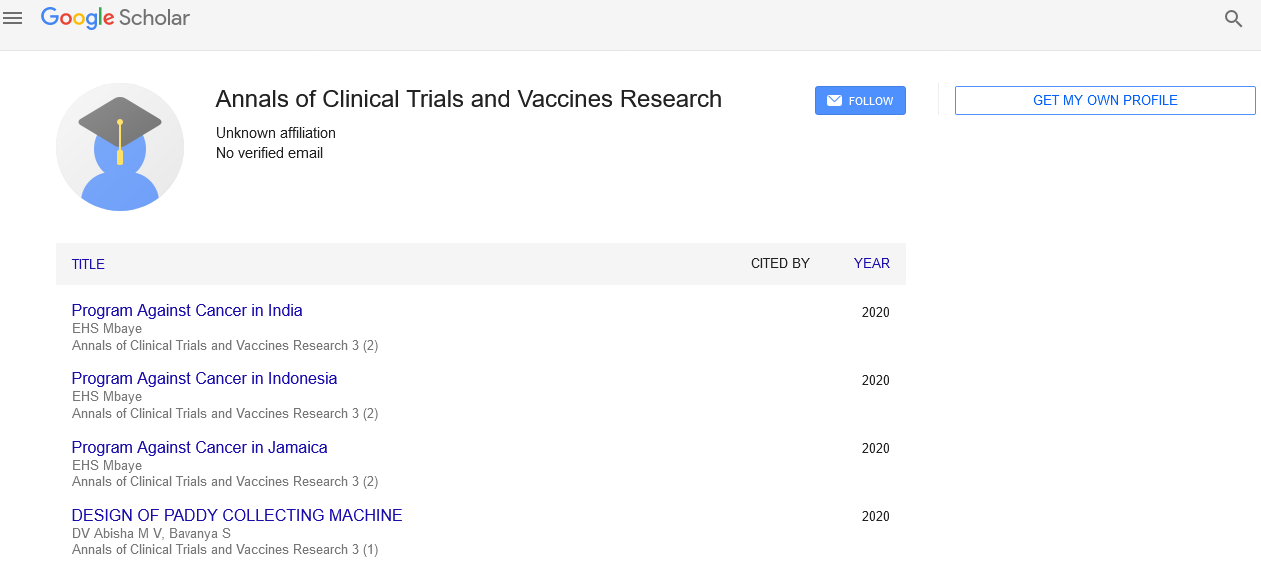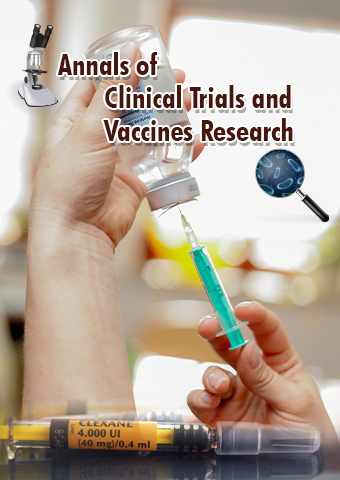Mini Review - Annals of Clinical Trials and Vaccines Research (2022) Volume 12, Issue 3
Ageing and basal cell carcinoma therapy
Yacob Mathai *
National Israeli Center for Psychosocial Support of Survivors, Israel
National Israeli Center for Psychosocial Support of Survivors, Israel
E-mail: yacobkm@gmail.com
Received: 01-Jun-2022, Manuscript No. ACTVR-22-70495; Editor assigned: 03-Jun-2022, PreQC No. ACTVR-22-70492 (PQ); Reviewed: 17- Jun-2022, QC No. ACTVR-22-70492; Revised: 22-Jun-2022, Manuscript No. ACTVR-22-70492(R); Published: 29-Jun-2022, DOI: 10.37532/ actvr.2022.12(3).50-52
Abstract
The form of skin cancer that is most frequently diagnosed is basal cell carcinoma (BCC). BCCs are more common in the older population than in younger people, perhaps as a result of their link to cumulative sun exposure and other risk factors. In this article, we discuss geriatric ideas relevant to the treatment of senior citizens with BCCs. In order to better understand whether patients will experience the efficacy of a treatment within their life span, we discuss how a patient’s life expectancy may be assessed and paired with tumour features to predict lag time to benefit. We also discuss the potential for current BCC overdiagnosis and list the effectiveness, advantages, and disadvantages of typical BCC therapies, highlighting that all treatment methods require extra attention when given to older persons. In particular, older persons with a short life expectancy may favour nonsurgical therapy [1]. In the end, we contend that the choice of whether and how to treat a BCC should be the outcome of collaborative decision-making between the patient and the healthcare professional and take into consideration both tumour features and patient values and preferences.
Keywords
basal cell carcinoma • cryosurgery • dermatologic surgery • elderly • electrodessication and curettage • imiquimod • life expectancy • mohs surgery • nonmelanoma skin cancer • photodynamic therapy • vismodegib
Introduction
With millions of new cases reported each year in the United States, basal cell carcinoma (BCC) is the most frequently diagnosed cancer overall. Its frequency is gradually rising, especially in older persons. BCC is normally a non-aggressive malignancy; as a result, mortality from BCC is uncommon. Tumors develop slowly and seldom ever metastasis (metastatic rate 0.1 percent). However, more than 100,000 individuals are treated for BCC each year in their final year of life, despite the likelihood that those with BCCs would die from other reasons. In this article, we discuss geriatric concepts including life expectancy, functional status, and lag time to benefit that are pertinent to the treatment of older persons with BCC [2]. Additionally, we list the efficacy, advantages, and hazards of typical BCC therapies and discuss unique factors to take into account in older persons. Overall, we contend that knowing patient values and preferences and determining whether and how to treat a BCC depend on successful shared decision-making between the patient and the clinician.
When treating any condition in elderly individuals, a number of important factors, such as life expectancy, functional state, and lag time to benefit, should be taken into account. The estimated number of years a person will live after their projected lifespan. Based on statistics from the national census, a rough estimate of life expectancy in the United States may be made. In a sample of 80-year-old men, 25% are predicted to live an additional 11 years, 50% are predicted to live an additional 6.7 years, and 25% are predicted to live less than an additional 3 years. However, since the health of an individual is not taken into account in the census data tables, a particular person’s life expectancy may vary greatly from that predicted by age alone. Providers can thus use preprogramed life expectancy calculators that take comorbidities and functional status into consideration to provide a more precise and personalised life expectancy prognosis.
A provider can determine whether a given intervention will benefit a patient within an appropriate period or whether the risks of an intervention outweigh the benefits in the patient’s remaining years of life by combining information about a patient’s tumour characteristics with a patient’s life expectancy. The idea of “lag time to benefit” requires us to think about when a therapy will be helpful in respect to the patient’s expected lifespan in addition to how successful it is [3].
When cancer screening detects cancers that would not have manifested symptomatically throughout the patient’s lifetime-either because the illness never advances, regresses spontaneously, or develops so slowly that the patient passes away from another cause-the patient is over diagnosed. Lowgrade prostate cancer is an oncology case that has been extensively investigated. Although improvements in diagnostic technology resulted in the discovery of more prostate cancer cases, the number of deaths attributable to the illness remained similar since the discovery of these additional instances had no impact on disease-specific mortality. For males aged 70 and older, prostate-specific antigen screening is not currently advised by the United States Preventive Services Task Force. Similar to BCCs, improvements in skin cancer diagnosis over the past few decades have significantly increased their occurrence, particularly in older individuals. However, these higher identification rates have not led to a decrease in the disease-specific mortality from BCCs. According to the findings, the majority of senior patients with NMSC, including BCC, die from unrelated reasons. In a research with 1,360 patients treated for NMSC, 332 individuals were identified as having a restricted life expectancy; nevertheless, no deaths were attributable to NMSC, even though 43% of patients with a limited life expectancy passed away within 5 years. The United States Preventive Services Task Force emphasised in its most current guideline on skin cancer screening that there is a possibility for BCC over diagnosis [4].
Can be treated surgically and nonsurgical in a number of ways. Surgical techniques are used more frequently in general because they have a better success rate. Nonsurgical treatments are typically reserved for patients who cannot tolerate or do not want to undergo surgical treatment, for BCCs patients with locally advanced or metastatic disease, and for patients with high-risk tumours (e.g., recurrent, poorly defined borders, aggressive histologic growth patterns) in difficult-totreat areas. In general, extra considerations must be taken for older patients when providing treatment alternatives, even if suggested treatment methods are highly reliant on the particular features of both the patient and the tumour. The success, advantages, and disadvantages of typical surgical and nonsurgical therapies for BCCs are outlined in the following section, along with additional considerations for each approach in older persons. In the end, we contend that elderly individuals with a short life expectancy may choose nonsurgical treatments [5].
Materials and Methods
A retrospective nationwide cohort study involving patients with advanced RCC who had received targeted therapy (sunitinib, sorafenib, pazopanib, everolimus, or temsirolimus) or cytokine therapy (interleukin-2 or interferon gamma) from 2007 to 2018 was carried out using Taiwan’s National Health Insurance Research Database. The propensity score approach of stabilised inverse probability of treatment weighting was used to estimate the risk for MACE (a composite of myocardial infarction, ischemic stroke, heart failure, and cardiovascular mortality) in the cohort.
This retrospective investigation involved multiple institutions. Retrospective analysis was performed on 88 RMHNC Japanese patients with squamous cell carcinoma who received nivolumab between May 2017 and May 2018. The best overall response (BOR), progression-free survival (PFS), and overall survival (OS) were assessed. The prognostic factors were found using both univariate and multivariable analysis [6].
Discussion
To our knowledge, this is one of the broadest evaluations of the clinical effectiveness of immunotherapy and target therapy in patients with metastatic Xp11.2 translocation renal cell carcinoma with regard to system therapy. As illustrated by a median PFS of 5.4 to 7.4 months and a median OS of 17.1 to 17.3 months in the first-line scenario, the results of the current trial showed that the firstgeneration VEGF-TKI therapy can be of some benefit in adult patients with metastatic Xp11.2 translocation renal cell carcinoma [7].
Results
The analysis included 216 patients’ 234 superficial BCCs. 171 out of 234 BCCs (73 percent) exhibited a “high clearance” at the 6-month follow-up visit, whereas 63 lesions (27 percent) displayed a “partial response.” Within 24 months, 28 out of 171 high clearance BCCs (16%) showed a recurrence. The mean surface size of lesions differs significantly between “partial response” and the “high clearance” or “maintained clearance” group, with greater values in “partial response [8].” Within 24 months, BCCs of the head and neck are twice as likely to return. At 30 days after PDT biopsy, 85% of Standard PDT and 93.3 % of Single-visit PDT patients had a full recovery. During the second session of the Singlevisit PDT, there was less pain experienced during the illumination. After 60 months, the recurrence-free follow-up revealed a cumulative probability of recurrence-free for Standard PDT of 69.0 percent and an 80.6 percent for Single-visit PDT of 80.6 percent [9].
Conclusions
BCC is quite prevalent and is becoming worse. Future population growth, especially among elderly persons, will exacerbate this issue. There is no one-size-fits-all suggestion for the treatment of these tumours; rather, healthcare professionals must consult with patients and their families to choose the best course of action. Geriatrics concepts must be used to dermatological practise in order to provide better treatment for our patients. [10].
Acknowledgments
None
Conflict of interest
None
References
- Motley RJ. The treatment of basal cell carcinoma. J Dermatol Treat. 6, 121-5 (1995).
- Emmett AJ. Surgical analysis and biological behaviour of 2277 basal cell carcinomas. Aust N Z J Surg 60, 855-63 (1990).
- Leffell DJ, Headington JT, Wong DS et al. Aggressive-growth basal cell carcinoma in young adults. Arch Dermatol .127, 1663-7 (1991).
- Salasche SJ, Amonette R. Morpheaform basal-cell epitheliomas: a study of subclinical extensions in a series of 51 cases. J Dermatol Surg Oncol. 7, 387-92 (1981).
- Satinoff MI, Wells C. Multiple basal cell naevus syndrome in ancient Egypt. Med Hist. 13, 294-7 (1969).
- Farndon PA, Del Mastro RG, Evans DG et al. Location of gene for Gorlin syndrome. Lancet. 339, 581-2 (1992).
- Gorlin RJ, Goltz RW. Multiple nevoid basal-cell epithelioma, jaw cysts and bifid rib: a syndrome. N Engl J Med. 262, 908-12 (1960).
- White JC. Multiple benign cystic epitheliomas. J Cutan Genitourin Dis. 12, 477-84 (1894).
- Silverman MK, Kopf AW, Grin CM et al. Recurrence rates of treated basal cell carcinomas. J Dermatol Surg Oncol. 18, 549-54 (1992).
- Thissen MR, Neumann HA, Schouten LJ. A systematic review of treatment modalities for primary basal cell carcinomas. Arch Dermatol. 135, 1177-83 (1999).
Google Scholar, Crossref, Indexed at
Google Scholar, Crossref, Indexed at
Google Scholar, Crossref, Indexed at
Google Scholar, Crossref, Indexed at
Google Scholar, Crossref, Indexed at
Google Scholar, Crossref, Indexed at
Google Scholar, Crossref, Indexed at

